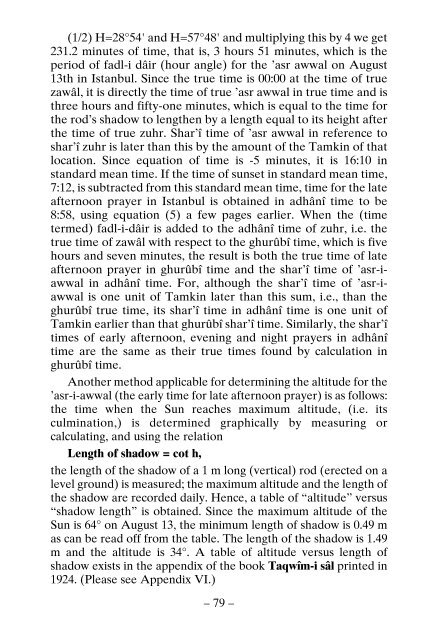O Son !
THE BOOK ‘O SON’ Al-hamdu lillâhi Rabbil ’âlamîn. Wa-s-salâtu wa-s-salâmu ’alâ Rasûlinâ Muhammadin wa Âlihi wa Sahbihi ajma’în. 1– O son! Collecting from books written by the scholars of the Hanafî Madhhab three hundred and sixty hadîth-i-sherîfs and forty-four khabars and also the seven essentials and the five rukns and the seven wâjibs and the fourteen sunnats and the twenty-five mustahabs and the fourteen mufsids of namâz, I have explained them for you. Adapt your acts and deeds to these teachings so that you attain fayz and nejât (salvation)! 2– Also for your information, I have collected a thousand and ninety âdâb (adabs) for you and for other young Muslims like you. If you adapt your actions and acts of worship to these teachings, they will be sufficient for you. If you laze, disobey Allâhu ta’âlâ and cease from these practices and manners, you will be afflicted with slavery and disgrace in the world and subjected to torment in the world to come. If you live up to them and advise your Muslim brothers to do the same, it will be useful for you. They will say blessings over you. And Haqq ta’âlâ will accept their invocations. For, a slave will be pardoned on account of another slave’s invocations for them.
THE BOOK ‘O SON’
Al-hamdu lillâhi Rabbil ’âlamîn. Wa-s-salâtu wa-s-salâmu ’alâ
Rasûlinâ Muhammadin wa Âlihi wa Sahbihi ajma’în.
1– O son! Collecting from books written by the scholars of the
Hanafî Madhhab three hundred and sixty hadîth-i-sherîfs and
forty-four khabars and also the seven essentials and the five rukns
and the seven wâjibs and the fourteen sunnats and the twenty-five
mustahabs and the fourteen mufsids of namâz, I have explained
them for you. Adapt your acts and deeds to these teachings so that
you attain fayz and nejât (salvation)!
2– Also for your information, I have collected a thousand and
ninety âdâb (adabs) for you and for other young Muslims like you.
If you adapt your actions and acts of worship to these teachings,
they will be sufficient for you. If you laze, disobey Allâhu ta’âlâ
and cease from these practices and manners, you will be afflicted
with slavery and disgrace in the world and subjected to torment in
the world to come.
If you live up to them and advise your Muslim brothers to do
the same, it will be useful for you. They will say blessings over you.
And Haqq ta’âlâ will accept their invocations. For, a slave will be
pardoned on account of another slave’s invocations for them.
Create successful ePaper yourself
Turn your PDF publications into a flip-book with our unique Google optimized e-Paper software.
(1/2) H=28°54' and H=57°48' and multiplying this by 4 we get<br />
231.2 minutes of time, that is, 3 hours 51 minutes, which is the<br />
period of fadl-i dâir (hour angle) for the ’asr awwal on August<br />
13th in Istanbul. Since the true time is 00:00 at the time of true<br />
zawâl, it is directly the time of true ’asr awwal in true time and is<br />
three hours and fifty-one minutes, which is equal to the time for<br />
the rod’s shadow to lengthen by a length equal to its height after<br />
the time of true zuhr. Shar’î time of ’asr awwal in reference to<br />
shar’î zuhr is later than this by the amount of the Tamkin of that<br />
location. Since equation of time is -5 minutes, it is 16:10 in<br />
standard mean time. If the time of sunset in standard mean time,<br />
7:12, is subtracted from this standard mean time, time for the late<br />
afternoon prayer in Istanbul is obtained in adhânî time to be<br />
8:58, using equation (5) a few pages earlier. When the (time<br />
termed) fadl-i-dâir is added to the adhânî time of zuhr, i.e. the<br />
true time of zawâl with respect to the ghurûbî time, which is five<br />
hours and seven minutes, the result is both the true time of late<br />
afternoon prayer in ghurûbî time and the shar’î time of ’asr-iawwal<br />
in adhânî time. For, although the shar’î time of ’asr-iawwal<br />
is one unit of Tamkin later than this sum, i.e., than the<br />
ghurûbî true time, its shar’î time in adhânî time is one unit of<br />
Tamkin earlier than that ghurûbî shar’î time. Similarly, the shar’î<br />
times of early afternoon, evening and night prayers in adhânî<br />
time are the same as their true times found by calculation in<br />
ghurûbî time.<br />
Another method applicable for determining the altitude for the<br />
’asr-i-awwal (the early time for late afternoon prayer) is as follows:<br />
the time when the Sun reaches maximum altitude, (i.e. its<br />
culmination,) is determined graphically by measuring or<br />
calculating, and using the relation<br />
Length of shadow = cot h,<br />
the length of the shadow of a 1 m long (vertical) rod (erected on a<br />
level ground) is measured; the maximum altitude and the length of<br />
the shadow are recorded daily. Hence, a table of “altitude” versus<br />
“shadow length” is obtained. Since the maximum altitude of the<br />
Sun is 64° on August 13, the minimum length of shadow is 0.49 m<br />
as can be read off from the table. The length of the shadow is 1.49<br />
m and the altitude is 34°. A table of altitude versus length of<br />
shadow exists in the appendix of the book Taqwîm-i sâl printed in<br />
1924. (Please see Appendix VI.)<br />
– 79 –

















